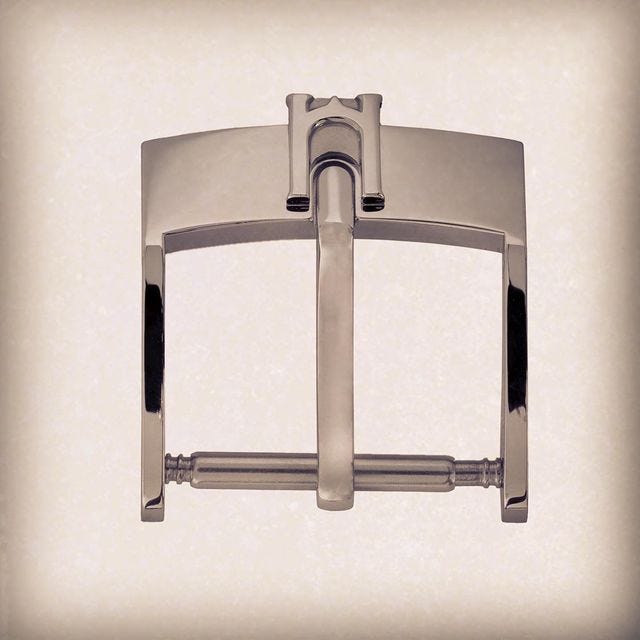Massena Lab’s next project launches on October 20. It looks like it’ll be some sort of play on the Universal Geneve Uni-Compax “Big Eye” (see below for the full article). But before we get hyped about the potential return of Universal Geneve, I wanted to take a look at the history of the Uni-Compax.
A brief history of the Universal Geneve Uni-Compax
Instead of starting at the beginning this week, let’s start at the end.
In 1989, Universal Geneve — or rather, the shell of the once venerated Swiss watch brand — was bought by Stelux, a Hong Kong-based investment group. The acquisition came after Universal Geneve had hollowed itself out over the previous two decades, heavily transitioning to producing quartz watches in response to the Quartz Crisis. From the looks of it, Stelux has quite the portfolio: according to its website, a year before acquiring Universal Geneve, it acquired “an up and coming optical business,” subsequently moving it to a health-care based model to capture the fast-growing "silver-haired" demographic. So I guess Universal Geneve was similarly charted on a health-care based model to realize synergies on these two acquisitions?
Universal Geneve is widely remembered as one of the most tragic losses to the Quartz Crisis: a brand that once held a status approaching that of Omega or Longines. Hell, Henri Stern Agency, the firm that sold Patek Philippe into the U.S. market, also sold Universal Geneve timepieces alongside Patek. I mean, if Hermes felt comfortable putting its name underneath Universal Geneve on the dial, that says it all.
Universal Geneve’s demise is especially startling because if you look at the 1960s, no one was doing it like them. The brand’s sports watches from this final era of pure, unadulterated Universal Geneve are unlike anything else you’ll find from other brands. For example, they were dropping a triple calendar with moonphase chronograph into a sports watch’s body, just because. And if that’s not enough, Eric freaking Clapton was wearing it, literally buying it the year it came out. I mean, come on. Put beside more austere contemporaries like the Rolex Daytona or Heuer Carrera, Universal Geneve’s watches were often bold and different; but, with models like the Uni-Compax still measuring around 37mm, they remain exceedingly wearable. Somehow, Universal’s design choices foreshadowed the bold, brash aesthetics of the 1970s, while staying true to the more minimalist choices of the 1960s.
Big Eye: When the moon hits your eyes like a big pizza pie
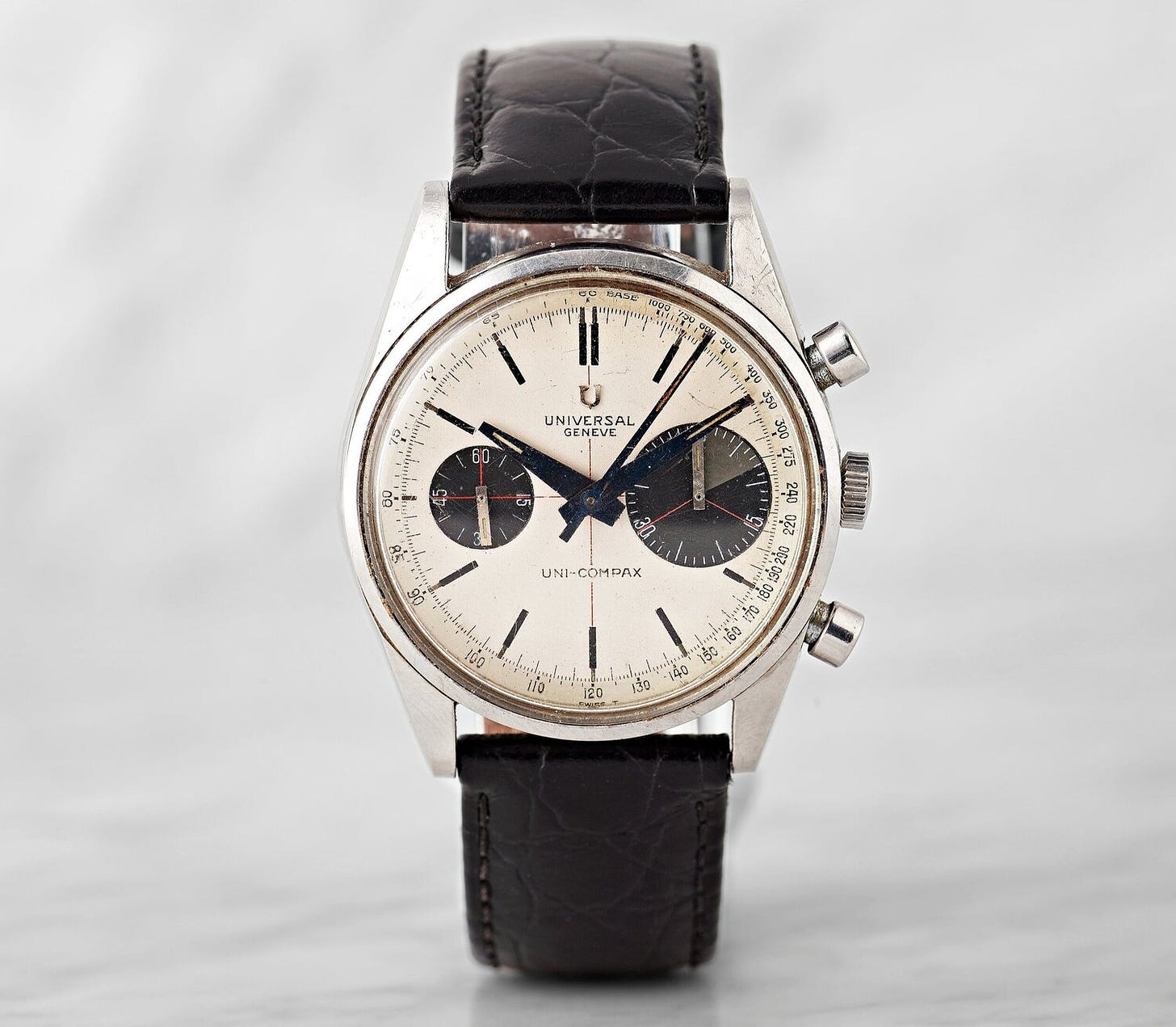
Credit: Bukowski’s
The real bad ass of Universal Geneve’s 1960s collection may have been the Uni-Compax “Big Eye” reference 884100/01 (black dial) and 884100/02 (white dial). The Uni-Compax had long been a stalwart of Universal Geneve’s collection, but never like this. It’s a simple two-register chronograph, but with the Big Eye, Universal boldly pushed what had previously been a staid dress chronograph into a new era. The Big Eye was produced for just a couple of years in the mid-1960s. As far as I can tell, no one really knows how many were actually produced, though some have claimed as few as 100. More importantly, no more than a few dozen have surfaced on the contemporary market. That’s why, for example, a dial alone can fetch £1,500 at auction (in 2015; and it’s not like it’s cheap to put together the other pieces of a correct Big Eye).
The Big Eye owes its name to the large chronograph counter at 3 o’clock, enlarged to optimize visibility for drivers and egg timing. But, more important than any supposed functionality is how awesomely ridiculous it looks. I’ve often preferred two-register chronograph to three-register layouts for their symmetry, but the Big Eye gives a big middle finger to that rationale. While the radius of that Big Eye measures just a couple ticks larger than the smaller running seconds indicator, some basic high school calculations[1] show how the Big Eye’s area is actually two times that of its smaller companion, leading to the 3 o’clock sub dial’s total dominance over the entire dial.
Somehow though, the dial still feels balanced. perhaps it’s the grey pizza slice taken out of the Big Eye from 0-8 minutes. (I think this had to do with long-distance calling or something. I don’t know, I get free long-distance with AT&T.) Flip over the dial and you’ll see it’s made by Singer, the manufacturer who also made dials for Daytonas, Speedmasters, and other such mid-century icons. Red crosshairs in the middle of both the 884100/01 and 884100/02, as well as divvying up the sub-dials provide a nice complement to the panda and reverse panda color schemes. In a way, these crosshairs actually remind of those you’d find on the Universal Geneve Polerouters of the 1950s. It’s fun to find these small through lines in a brand’s design language.
The reference 884100 is equipped with the Universal Geneve caliber 125, a modified Valjoux 23. It’s a column-wheel chronograph from the Valjoux 72 family, parred back to remove the third sub-dial (chronograph hour counter) and reduce the minute counter to 45 minutes. Watches powered by this family of calibers are instantly recognizable because the 4 o’clock pusher sits slightly farther from the crown than the 2 o’clock pusher. In fact, the 1960s were an interesting time for Universal Geneve, as it moved to using Valjoux ebauche movements after selling off its Martel movement manufacturing partner to Zenith (Martel had supplied the previous generation Universal Geneve caliber 285. Zenith would then go on to use Martel’s expertise to develop the first automatic chronograph movement).[2]
The handset on the Big Eye looks similar to that found on contemporary Universal Geneve chronographs of the time, including the Nina Rindt and Eric Clapton. The wide hour, minute, and matching chronograph seconds hands are sporty and bold, and the blocky steel sub-dial hands particularly stand out against the panda/reverse panda dial. The applied Universal Geneve logo at 6 o’clock adds just a bit of elegance, especially when compared to later models from the brand that feature printed logos (you won’t find printed logos on the Big Eye). This is quickly countered by the Base 1000 outer tachymeter scale on the dial.
The black dial (reverse panda) variant seems to be less rare than the white dial panda layout, though both are grails and your collecting decisions should be based more on personal taste than supposed rarity.
Early Uni-Compax: That’s amore
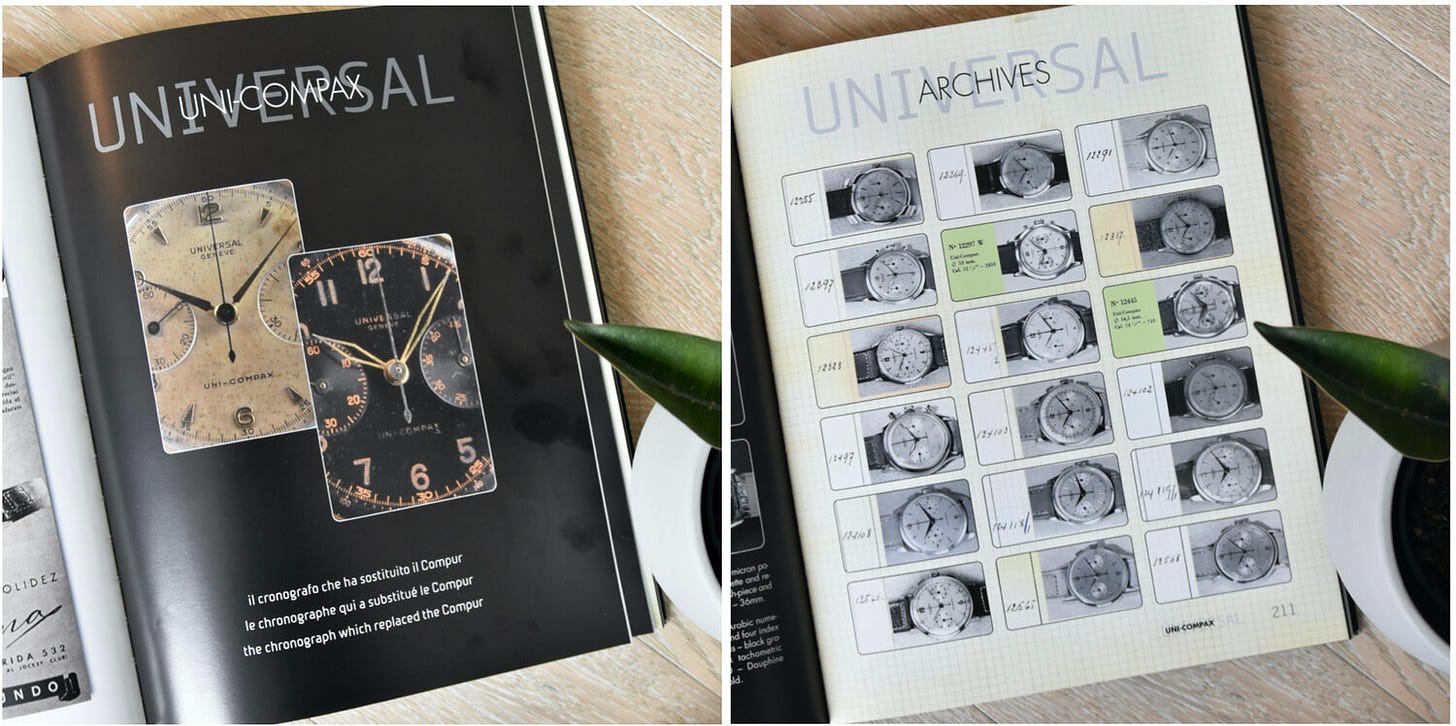
Photos from Universal Watch Geneve by Pietro Sala, now available online
Listen, the Big Eye is a cool watch, but it’s made much better when one sees the Uni-Compax references that came before it. Universal Geneve introduced the Uni-Compax model in the 1940s as it phased out the Compur. Throughout the 1940s and 50s, Universal Geneve produced dozens of references bearing the Uni-Compax name on the dial. While all were powered by the 285 caliber family, they varied in size, shape, material, and pretty much every other way. If the Big Eye feels bold and modern, the pre-1960s Uni-Compax feels classic and understated. Cheap compared to a Compax or Tri-Compax from the era — and much cheaper than the Pateks it may have been sold alongside in the U.S. — the many variations almost hint at an effort to make a simple chronograph that could appeal to (and be afforded by) everyone. The chronograph for the people. If, in fact, that’s the unifying ethos of the Uni-Compax, it’s hard to argue with, and an ethos that persists to this day.
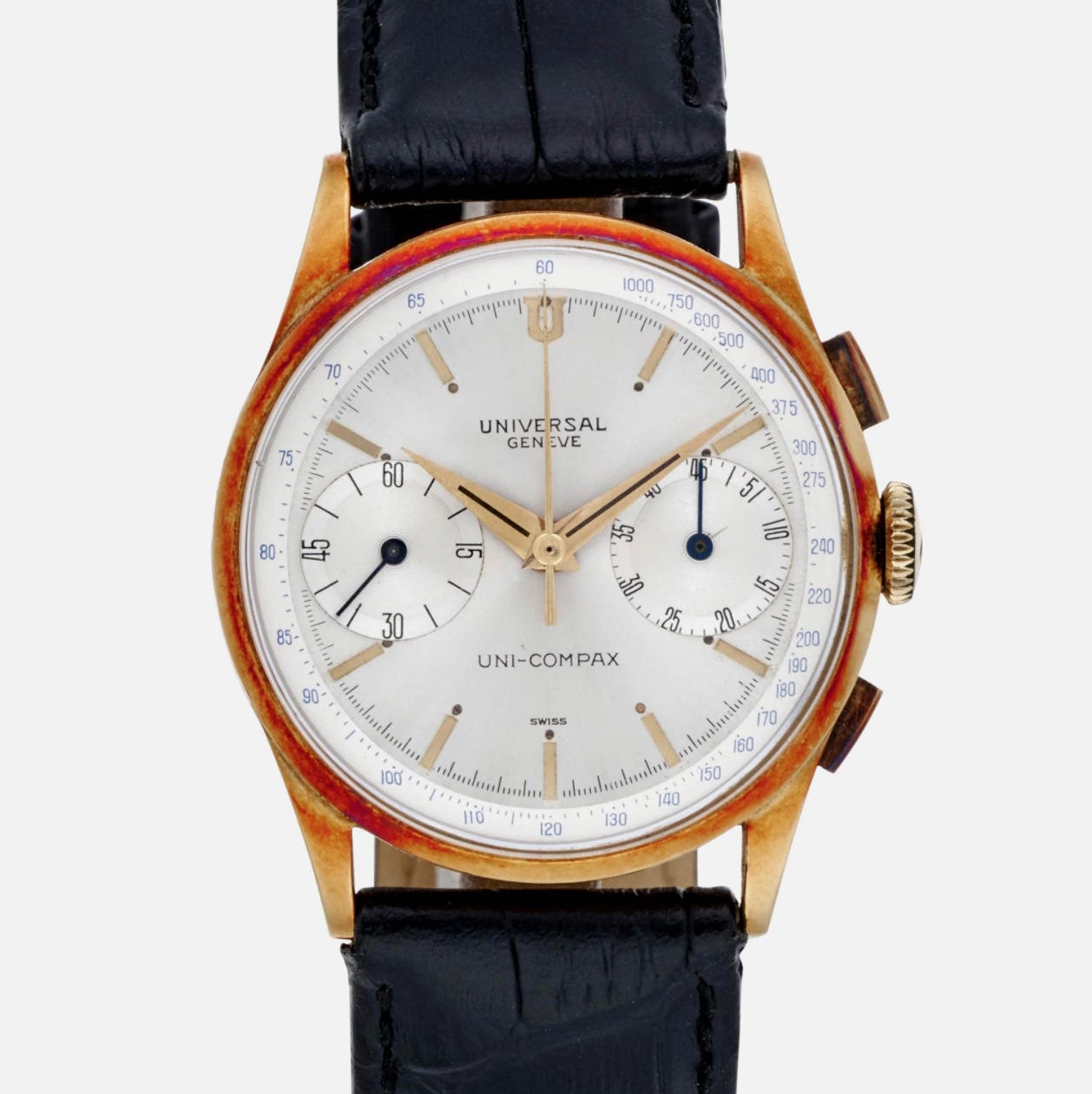
Universal Geneve Uni-Compax from 1940s | Credit: Hodinkee Shop
Today, Universal Geneve chronographs from the 1940s and 50s present an accessible entry point into vintage collecting. Martel’s chronograph movements from this era literally gave birth to the Zenith El Primero movement, the “first” automatic chronograph caliber. With some examples setting you back as little as a couple thousand bucks, the Uni-Compax is a legitimate way to own a piece of that historic chronograph lieneage and own a watch that sat comfortably next to Patek Philippes at the watch counter.
Some of the most collectible Uni-Compax models from this era are oversized models — measuring 38mm in diameter — especially those with waterproof cases manufactured by Spillman (hammer 136 in gold cases, for those following along in Sala. Spillman also manufactured Rolex Oyster cases).
Collecting the Big Eye
Sitting in 2020 A.D., to see these earlier Uni-Compax references but to know the abrupt turn that comes in the 1960s with the Big Eye is mind-boggling. Then, to know the demise that Universal Geneve would see just a few years after producing the Big Eye is even more confounding. It’s almost like the Big Eye was a last, audacious gasp to revive the once-proud Uni-Compax line, and thereby Universal Geneve as a whole. As it turns out, it was a brief gasp: few Uni-Compax “Big Eye” examples were actually produced, either for lack of trying or lack of demand. Either way, it’s a sad story for one astounding, asymmetrical watch.
While early Uni-Compax examples exist at nearly every price range, Big Eye prices have exploded as their rarity and bad assery has become recognized by the market. Recent examples have sold for more than $20,000, and examples currently on the market are listed above $30,000. As mentioned, both the 884100/01 and 884100/02 are exceedingly rare, though the white dial seems to be more rare and thus commands a slight premium as compared to the black dial.
Alpha Hands has a serial number project where he’s gathered all the examples he can find of the Big Eye reference 884100/02 (white dial). If you’re interested in acquiring one, this is a must-use resource.

Credit: Bukowski’s
Abbreviated list of sold ref. 81400 “Big Eye” Uni-Compax examples:
2019: 84100/01, sold £20,000 (Omega Forums); 2018: 884100/02, sold for SEK 140,000 (Stockholm Auktionsversk); 2018: /02, sold for SEK 300,000 (Kaplan’s); 2018: /01, sold for SEK 125,000 (Bukowski’s); 2018: /01, sold for CHF 41,250 (Christie’s); 2018: /01, sold for 23,750 (Phillips); 2017: /02, sold for SEK 180,000 (Bukowski’s); 2016: /01, sold for CHF 32,500 (Phillips) (note red chronograph hand); 2015: /02, sold for £6,000 (Watches of Knightsbridge) (note different minute counter hand)
Footnotes
[1] That’s πr^2.
[2] There’s probably an interesting business school case study about outsourcing here. I remember learning Clay Christensen’s case study of Dell, where he points out that, over the years, Dell outsourced more and more of its manufacturing to a Taiwanese manufacturer so that Dell could focus on higher level, more profitable activities like design or marketing. In the end, the Taiwanese company started making its own computers, and Dell was little left with little more than its name. Was Universal Geneve getting “disrupted” before it was cool?
A Universal Release from Massena Lab
Awhile back, I reported that Universal Geneve was coming back soon, based on the re-registration of a few Universal Geneve trademarks and a bit of hope.
Well, 18 months later and the day might finally be here. Massena Lab, headed by William Massena, an industry veteran who’s pretty much done it all in watches, is teasing a release on October 20. The first hint that the release might be a Universal Geneve watch comes on the launch’s landing page, which, for those old enough to remember, might evoke motion picture memories:

The graphic is a play on the opening graphic that Universal Studios used to use for movies. Of course, Universal has updated the graphic over the years, but even today it still resembles this old graphic, with the word Universal superimposed over the globe.
Okay, that’s cute, but I probably wouldn’t be publishing this story if that’s all I had to go on. Here’s the clincher: in 2019, Massena Lab’s company registered the trademark “Uni-Compax”.
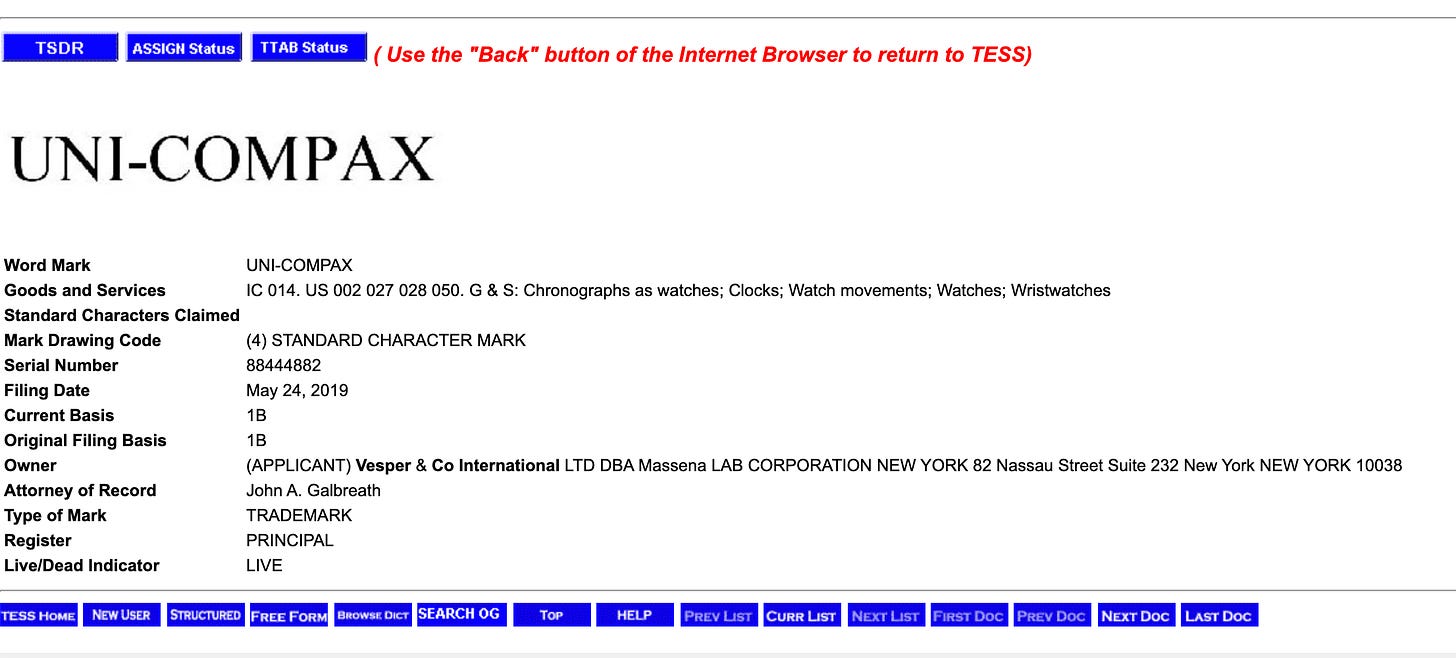
The Universal Geneve Uni-Compax “Big Eye” from the 1960s are perhaps the most popular vintage Uni-Compaxes from the back catalog, so it wouldn’t be surprising if Massena Lab drew inspiration from these references. Mr. Massena has also posted various teasers on his Instagram page. Most notably, he posted a strap buckle with a logo that bears a striking resemblance to the vintage Universal Geneve “U”:
Massena Lab has collaborated with a number of brands on excellent releases over the past few years, including Habring2, Unimatic, and MB&F. Each of its releases has been nearly universally applauded by collectors and enthusiasts. If Universal Geneve, a brand that essentially died during the quartz crisis and is now beloved by vintage enthusiasts (especially for its array of chronographs) is going to be brought back, the team at Massena Lab is as capable as any of achieving a successful revival. It’s hard to know what exact form a modern Massena Lab Uni-Compax might take. But here’s to hoping for a potential revival of the Universal Geneve Uni-Compax that’s as good as the originals.
Through the Wire
👀 Big Eyes on Sale. Analog Shift has both a reverse panda and panda dial UG Big Eye on sale right now. The reverse panda is listed for $35k, and while the panda is “price on request,” you can bet it’s more.
🐟 Salmon Santos for sale (briefly). The Cartier Santos 90th Anniversary Limited Edition is one of the most beautiful watches of the past 30 years (im[not so]ho). Released in 1994, designed to honor the 90th anniversary of the original Santos-Dumont and limited to just 90 pieces, they rarely appear, and prices have risen quickly over the past few years. This week, an example briefly appeared from Mr. Watchley, a dealer based out of Ghent, Belgium. To take just a few recent examples to illustrate the trend: Christie’s sold an example for $7,500 in 2017; Sotheby’s (here) and Christie’s (here) then sold examples for about $12,500 and $13,750, respectively, in 2018. In October 2019, Sotheby’s then sold an example for closer to $17,000. Measuring just 27mm and only 1.5mm thick thanks to the super-slim Piguet caliber 21, it’s definitely a petite watch, but don’t knock it until you’ve tried it. Mr Watchley’s example sold quicker than it takes to overcook a salmon, and with good reason. Just look at it:
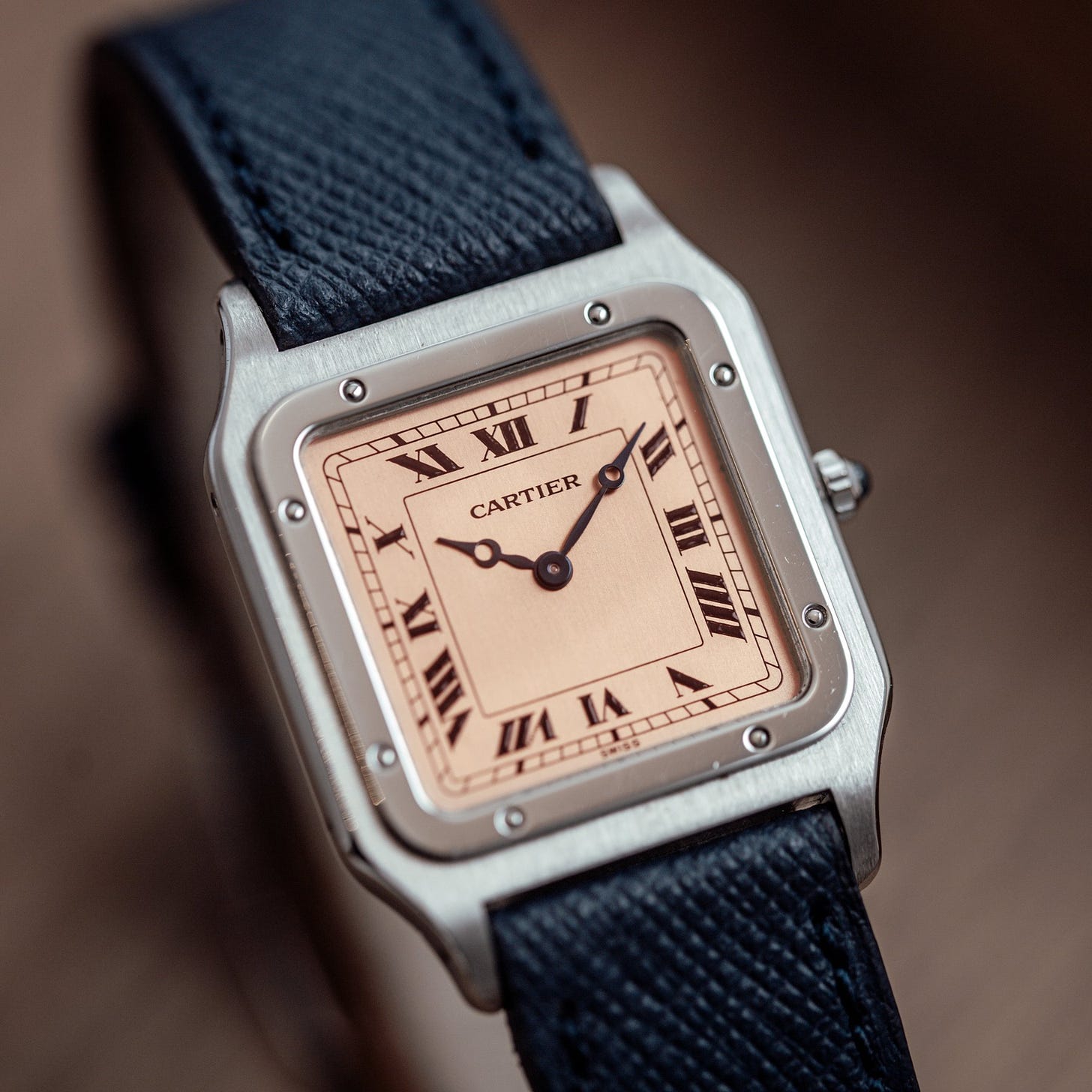
🏎 Porsche the “most valuable luxury brand”; Rolex No. 8. Porsche and Gucci appeared on top of Brand Finance’s yearly ranking of the most valuable luxury brands. The watch brands (or brands that make watches) that appear in the top 50 (along with their parent company): #4 Cartier (Richemont); #8 Rolex, #18 Omega (Swatch Group), #21 Bulgari (LVMH); #25 Tag Heuer (LVMH), #39 Tissot (Swatch Group; also, wut?), #42 Montblanc (Richemont), #44 Longines (Swatch Group). I wonder where Tudor is? If Tissot is #39, I have to believe Tudor is higher. Perhaps its brand value just accrues to Rolex?
👸 Is Meghan Markle wearing Princess Diana’s Cartier Tank? (h/t Charlie) 🗓 With a ton of auctions coming this fall, here’s a calendar to help keep track. 😷 NYT: 4 moments that changed the watch world.
Thanks for reading! - Tony




